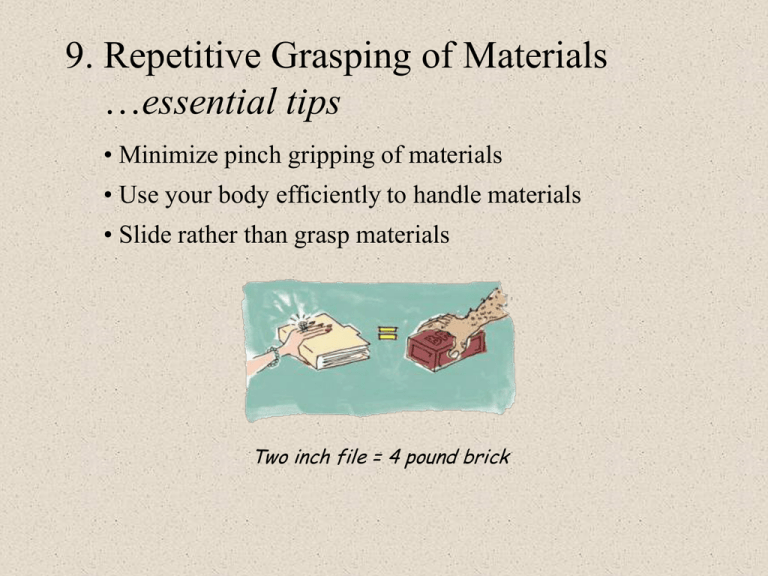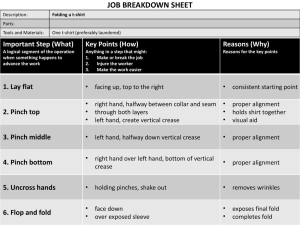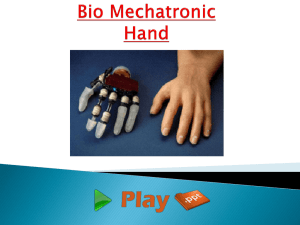9. Repetitive Grasping of Materials …essential tips
advertisement

9. Repetitive Grasping of Materials …essential tips • Minimize pinch gripping of materials • Use your body efficiently to handle materials • Slide rather than grasp materials Two inch file = 4 pound brick Repetitive Gripping / Grasping …minimize pinch Pinch grip position Downward forces Repetitive pinch gripping is a known risk factor for developing hand, wrist and elbow disorders. The muscle/tendon structures of the hands (fingers and thumbs) are not well suited for grasping an object with only the fingertips, particularly when it is heavy and awkward. Grasping and twisting motions are often required to handle and shelve books and files, which can also put stress on the elbows. Consider, when holding a file folder most of the load is a distance from the point of grip (fulcrum), which requires greater forces to be exerted. Added grip forces are required to create enough friction to overcome the slippery and unstable characteristics of paper (floppy). Be aware, a 2-inch thick file folder or binder weighs about 4.4 pounds- the exact weight of a masonry brick. Repetitive Gripping / Grasping …minimize pinch gripping Okay! Okay! Avoid! When possible, try to grasp heavy or large paper materials with 2 hands at the center to create a balanced load. Or, grasp the item with a full hand rather than with the fingertips to reduce the torque of the load. Rubber gloves or rubber fingertips can be helpful in creating better friction between your hand and the paper material to reduce grip forces. Repetitive Gripping / Grasping …minimize pinch gripping Particularly thick or heavy items such as reams of copy paper or “fat files” should be stored flat on shelves so they can be grasped with 2 hands. Ideally, such bulky items should be placed at heights below the shoulders and above the waist to minimize loads on the shoulders and/or spine. Repetitive Gripping / Grasping …using an efficient “handshake” wrist posture Smaller and lighter items such as file folders, manuals and thin binders should be stored on shelves vertically so they can be grasped with a full-hand grip and with a neutral wrist posture that resembles a “handshake” position. This puts much less stress on the hand and wrist. Always leave a few inches or so of open space on shelves to allow clearance to get your fingers between materials. Repetitive Gripping / Grasping …sliding rather than grasping materials If your work involves repetitive grasping of files or paperwork, You might want to set up your workstation so you can slide materials rather than grasping every item from a file or shelf. Using a side table to sort, stage and slide materials Ergo Fun Fact A design guide for the Americans with Disabilities Act (ADA) suggests that a work setting for people who must repetitively grasp materials should be designed with the notion that the “workers have no thumbs.” That is, if workers had no thumbs they would have no ability to pinch grip materials and they would have to rake and slide materials. Try duct taping your thumbs to your palms and doing your job without gripping. Repetitive Gripping / Grasping …sliding rather than grasping materials If your work involves a lot of gripping, grasping, sorting and transporting materials, try using surfaces and shelving that would allow you to slide materials rather than grasp and handle them. Also try to use mobile carts or mobile tables to assist you in moving materials to reduce lifting and handling whenever possible.



![Electrical Safety[]](http://s2.studylib.net/store/data/005402709_1-78da758a33a77d446a45dc5dd76faacd-300x300.png)







